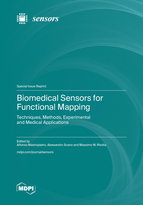Biomedical Sensors for Functional Mapping: Techniques, Methods, Experimental and Medical Applications
A special issue of Sensors (ISSN 1424-8220). This special issue belongs to the section "Biomedical Sensors".
Deadline for manuscript submissions: closed (31 March 2023) | Viewed by 38618
Special Issue Editors
Interests: MRI; EEG; signal processing; medical image analysis; diffusion MRI; advanced MRI approaches; quantitative MRI; mental workload; central nervous system; stroke; skeletal muscle; rehabilitation
Special Issues, Collections and Topics in MDPI journals
Interests: EMG; muscle synergies; motor control; neurological rehabilitation; signal analysis; kinematics; biomechanics; skeletal muscle; motion analysis
Special Issues, Collections and Topics in MDPI journals
Interests: signal processing; feature extraction; computational intelligence and computerized simulations for ECG signal processing and characterization
Special Issues, Collections and Topics in MDPI journals
Special Issue Information
Dear Colleagues,
Biomedical sensors are key components in various medical instruments and equipment and are valuable tools that provide functional information to better understand the underlying mechanism of relevant biological processes and interventions. The recent development of high-density systems, characterized by a high number of sensors arranged in specific configurations (matrices, arrays, wearable, etc.) has boosted the use of biomedical sensors for functional evaluation, including electrophysiological activity, metabolic response of organs and tissues, motor control analysis, adding meaningful spatial information. Functional mapping is becoming a popular approach for most of the common biomedical techniques (EEG, EMG, ECG, NIRS, MEG, etc.), and it improves the comprehension of complex biological behaviors where the spatial localization of the sensing methodology is crucial. Functional mapping that uses biomedical sensors can be helpful in different fields (neuroscience, neuromuscular physiology, rehabilitation, cardiology, etc.) either for diagnostic purpose or for the assessment of therapeutic interventions effectiveness.
The aim of this Special Issue is to collect papers describing cutting-edge techniques, methods and applications of biomedical sensors, as well as specific algorithms for data processing, which are able to provide functional information associated with the underlying spatial localization.
Both review articles and original research papers are solicited. There is particular interest in papers concerning medical applications where different biomedical devices or systems are used in a complementary approach coupled with clinical assessments.
Manuscript Submission Information
Manuscripts should be submitted online at www.mdpi.com by registering and logging in to this website. Once you are registered, click here to go to the submission form. Manuscripts can be submitted until the deadline. All submissions that pass pre-check are peer-reviewed. Accepted papers will be published continuously in the journal (as soon as accepted) and will be listed together on the special issue website. Research articles, review articles as well as short communications are invited. For planned papers, a title and short abstract (about 100 words) can be sent to the Editorial Office for announcement on this website.
Submitted manuscripts should not have been published previously, nor be under consideration for publication elsewhere (except conference proceedings papers). All manuscripts are thoroughly refereed through a single-blind peer-review process. A guide for authors and other relevant information for submission of manuscripts is available on the Instructions for Authors page. Sensors is an international peer-reviewed open access semimonthly journal published by MDPI.
Please visit the Instructions for Authors page before submitting a manuscript. The Article Processing Charge (APC) for publication in this open access journal is 2600 CHF (Swiss Francs). Submitted papers should be well formatted and use good English. Authors may use MDPI's English editing service prior to publication or during author revisions.
Keywords
- High-density electroencephalography (EEG);
- Multi-channel electromiography (EMG);
- Kinematics and motion analysis;
- Functional near infrared spectroscopy (fNIRS);
- Electrocardiography (ECG);
- Muscle synergies;
- Wearable sensors;
- Image and signal processing;
- Functional and effective connectivity;
- Applied machine learning.









